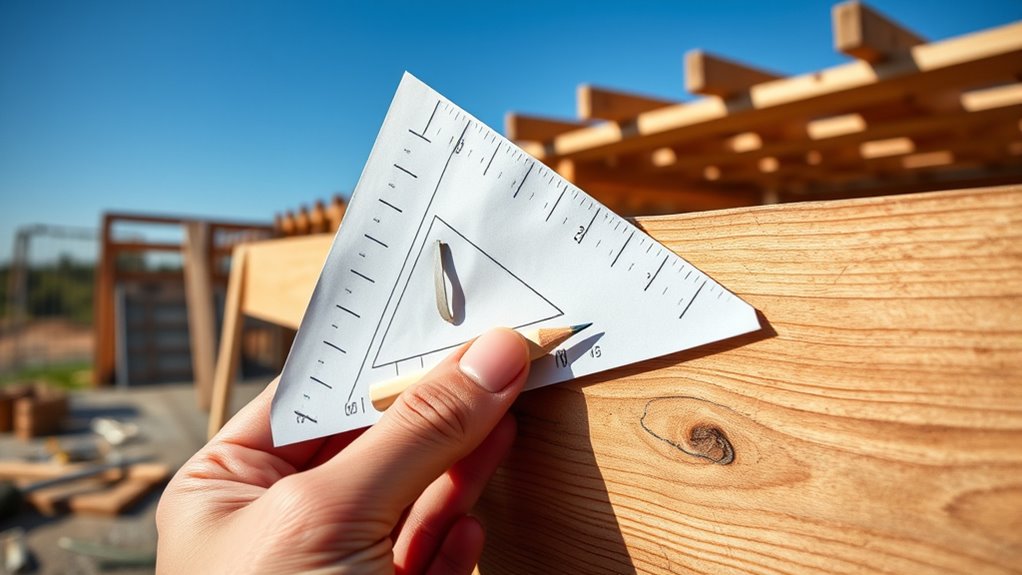To measure angles without special tools, start by recognizing common angles like right, acute, and obtuse, which are easier to identify visually. Use familiar objects, such as folded paper or corners of a square, as reference points. Employ simple techniques like aligning rulers or paper along one side of the angle or bisecting it to estimate its size. Practice and observation will help sharpen your skills further—explore more tips as you continue to refine your approach.
Key Takeaways
- Use familiar objects like squares or folded paper to create reference angles for comparison.
- Visually estimate angles by aligning them with known shapes, such as right angles or 45° splits.
- Fold paper to form angle templates, then compare or overlay them onto the target angle.
- Rely on quick visual cues, such as recognizing a right or acute angle, for faster estimation.
- Practice by comparing angles against standard shapes to improve accuracy and develop intuition.

Measuring angles accurately doesn’t always require specialized tools like protractors or angle finders. When you’re working on a project, whether it’s a DIY home improvement, an art project, or a quick measurement task, knowing how to estimate angles with what you have on hand can save you time and money. One of the most useful skills here is understanding protractor alternatives and mastering simple angle estimation techniques. These methods can help you get reasonably precise measurements without needing fancy equipment.
Start by leveraging your knowledge of common angles. For example, a right angle is 90 degrees, which you can recognize by the familiar shape of a square corner. Similarly, an acute angle is less than 90 degrees, and an obtuse angle is greater than 90 degrees but less than 180 degrees. By familiarizing yourself with these standard angles, you can quickly judge and compare angles in real-world situations. You might not get an exact measurement, but for many tasks, a close estimate is enough.
Knowing common angles helps you estimate and compare measurements quickly and accurately.
A practical protractor alternative involves using objects with known angles. For instance, a square or a piece of cardboard cut at a right angle can serve as a reference. If you’re trying to measure an angle on a piece of furniture or a structure, place your object against the angle and compare it visually to the known shape. You can also fold or mark paper to create a makeshift angle template. For example, folding a piece of paper diagonally creates a 45-degree angle. When you hold this template against the actual angle, you can estimate whether it’s sharper or wider than that baseline.
Angle estimation techniques also include simple geometric methods. For example, if you have a straight ruler or a piece of paper, you can use it to compare the angle’s opening against known reference points. By aligning the tool along one side of the angle and then gauging how far the other side deviates from a straight line, you can estimate the degree of the angle. Additionally, the “half-angle” method works well: if you can bisect the angle into two equal parts, you can compare each part to a known angle to get a rough estimate. Recognizing common angles used in Ananda Aromatherapy products can also provide helpful visual cues for estimation.
Finally, don’t underestimate the power of your own eye and experience. With practice, you’ll develop a good sense of how different angles look and can judge them with increasing accuracy. Although these techniques won’t replace precise measuring tools when high precision is necessary, they’re invaluable for quick estimates and everyday tasks. Using simple tools, familiar shapes, and your intuition, you become capable of measuring angles effectively without a protractor or specialized equipment.
Frequently Asked Questions
Can I Measure Angles Accurately Without Any Tools?
Yes, you can measure angles accurately without specialized tools by practicing angle estimation and creating homemade protractors. Use everyday objects like paper, straws, or cardboard to mark known angles, then compare your estimates to these references. By carefully observing and comparing angles visually, you can improve your accuracy over time. These simple methods help you measure angles effectively, even without traditional tools.
What Household Items Can Substitute for a Protractor?
You can substitute household items for a protractor using DIY angle tools and household measurement tricks. For example, a paper plate or a cardboard cutout can serve as a makeshift protractor. Use a ruler to draw lines from the center and measure the angles with a protractor app on your phone. These simple tricks help you measure angles accurately without specialized tools, making your project easier and more accessible.
How Do I Measure an Angle on an Irregular Shape?
To measure an angle on an irregular shape, start with angle estimation by visually comparing the shape’s lines to known reference angles. Use shape analysis to identify key points where lines intersect, then place household items like paper or cardboard along the lines to trace them. Carefully mark the points, then use a makeshift protractor or ruler to measure the angle between the traced lines, ensuring accuracy through careful observation and comparison.
Are There Apps or Digital Methods for Angle Measurement?
Yes, you can use digital apps and smartphone tools to measure angles. Many free or paid apps are available for download, allowing you to measure angles directly through your device’s camera or screen. Simply open the app, align your phone with the angle you want to measure, and let the app do the work. These digital methods are quick, convenient, and often quite accurate for everyday use.
How Do I Estimate Small Angles Without Precise Tools?
Did you know that humans can accurately estimate angles within about 5 degrees through visual estimation? When measuring small angles without precise tools, rely on geometric approximations. Align your eye with the vertex, and compare the angle to familiar objects or lines, like a quarter or a paper corner. Practice helps improve your accuracy, enabling you to estimate small angles effectively with just your eyes and everyday objects.
Conclusion
Remember, measuring angles without specialized tools is like finding your way with just a map and a compass—you don’t need high-tech gadgets to navigate effectively. I once helped a friend fix a crooked picture frame using only a protractor made from paper and a ruler. Just like that makeshift tool, your resourcefulness can turn everyday objects into practical measuring devices. With a little creativity, you’ll find that precise angles are within reach, no matter what tools you have on hand.









